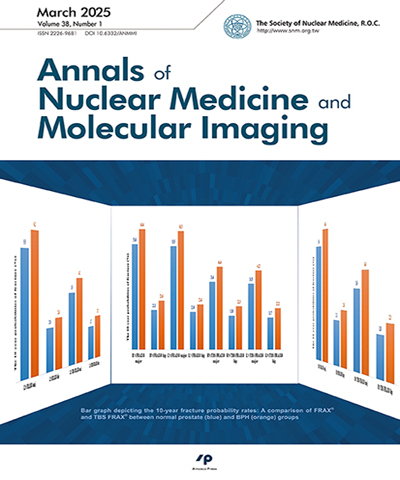
核子醫學暨分子影像雜誌/Annals of Nuclear Medicine and Molecular Imaging
中華民國核醫學學會 & Ainosco Press,正常發行
選擇卷期
- 期刊
Background: The adrenal gland is a common site of metastatic disease in oncology patients. The accurate characterization of adrenal lesions in images is important in avoiding unnecessarily invasive biopsies or surgeries. The aim of this study is to assess the value of dual time point F-18 fluorodeoxyglucose positron emission tomography/computed tomography (FDG-PET/CT) for differentiating malignant from benign adrenal lesions in patients with cancer. Methods: Patients with adrenal nodules (size > 1 cm) evidenced through dual time point (1 and 3 hours after injection) FDG-PET/CT were enrolled in this retrospective study. The 1 hour and 3 hour maximum standardized uptake values (SUV_(max)) of adrenal lesions were measured. The 1 hour and 3 hour adrenal SUV_(max) to liver SUV_(mean) ratios (A/L SUR) were calculated. The additional parameters of ΔSUV_(max), retention index of SUV_(max) (RI-SUV max), Δ A/L SUR, and RI-A/L SUR were also calculated. Results: A total of 36 patients were enrolled in this study. There were 41 adrenal lesions identified among 36 patients, including 15 malignant and 26 benign adrenal lesions. There were significant differences between malignant and benign lesions within the parameters of 1 hour SUV_(max), 3 h SUV_(max), ΔSUV_(max), 1 h A/L SUR, 3 h A/L SUR, ΔA/L SUR, and RI-A/L SUR. In the receiver operating characteristic curve analysis, the parameters of 1 hour SUV_(max), 3 h SUV_(max), 1 h A/L SUR, 3 h A/L SUR, and ΔA/ L SUR yielded excellent or good diagnostic performance results. In applying cutoff values of 1 hour SUV_(max) > 2.7, 3 h SUV_(max) > 2.8, 1 hour A/L SUR > 1.0, 3 hour A/L SUR > 1.15, and ΔA/L SUR > 0.18, the diagnostic accuracies were 82.9%, 82.9%, 85.4%, 85.4%, and 80.5% respectively. To maximize diagnostic accuracy, we developed a diagnostic algorithm using 1 hour SUV_(max) and ΔA/L SUR. Eleven adrenal lesions with 1 hour SUV_(max) less than 2.3 were all benign and 10 adrenal lesions with 1 hour SUV_(max) greater than 3.3 were all malignant. In the subgroup of 1 hour SUV_(max) 2.3 to 3.3, 12 adrenal lesions with ΔA/L SUR less than 0.18 were all benign and 5 of 8 adrenal lesions with ΔA/L SUR greater than 0.18 were malignant. The diagnostic accuracy was improved to 92.7%. Conclusion: Parameters of 1 hour SUV_(max), 3 h SUV_(max), 1 h A/L SUR, 3 h A/L SUR, and ΔA/L SUR in dual time point FDG-PET yield excellent or good diagnostic performance results in differentiating malignant from benign adrenal lesions. A diagnostic algorithm using 1 hour SUV_(max) and ΔA/L SUR can be helpful in improving diagnostic accuracy.
- 期刊
背景:現今醫學實驗室必須執行內部品管並且參加外部品管評估計劃(亦稱能力試驗),以確保實驗室的檢測品質。但倘若實驗室得到的品管不合格結果是源自於內外部品管提供機構,所提供的品管物質與試劑方法之間有干擾存,實驗室應要有驗證方法以確認實驗室的檢測品質。材料與方法:本研究以一般人類檢體匯集成三個不同濃度的人類血清檢體(serum pools),並以內部品管物質(lyphocheck control material)做比對驗證基礎,分析比較四種不同試劑方法的精密度(precision)、p值(p-value)、Z-評分(Z-Score),以客觀的統計數據驗證。結果:由數據中發現品管物質檢體和人類血清檢體之間存在著檢測結果的差異,且不同的試劑方法其差異性和差異程度亦不相同。結論:實驗室要正確的使用品管物質檢體,並且辨認其檢測結果的統計及詮釋方式是否正確,以及建立實驗室的驗證方法,方能判斷實驗室的檢測品質是否符合要求以避免啟動不必要的檢討措施造成額外的檢測成本增加和後續的醫療風險。
- 期刊
Cryptorchidism is the absence of one or both testes from the scrotum. Confirmative diagnosis after adulthood is rare. A 21-year-old man was accidentally diagnosed with unilateral cryptorchidism after a whole-body FDG PET/CT scan for a health check-up. On the imaging, there was no physiological uptake in the left scrotum. On the contrary, a low grade FDG-avid lesion was noted in the left inguinal region. A follow-up urological ultrasound examination and monitoring confirmed the diagnosis. This case reminds us that an abnormal FDG uptake in a man's inguinal region should prompt us to consider examination of undescended testes to avoid misdiagnosing the case as some other lymphoid disease.
- 期刊
Bowel metastasis from lung cancer has rarely been described. In this study, we report on a 72-year-old man with squamous cell carcinoma of the lung and his status post-operation. He was noted to have tarry stool and decreased levels of hemoglobin. A colonoscopy was performed and a biopsy of a descending colon lesion showed metastatic squamous cell carcinoma. On F-18 fluoro-2-deoxy-D-glucose positron emission tomography/ computed tomography (F-18 FDG PET/CT) images, an intensely FDG-avid colon lesion was compatible with a metastatic lesion. In addition, several focally intense FDG-avid lesions were found in the small bowel with corresponding mass-like lesions on CT images. Metastasis to the small bowel was highly suspected.
- 期刊
We present a case with I-131 whole-body scanning after I-131 radioablative treatment. I-131 whole-body scan was obtained 5 and 8 days after I-131 radioablative treatment. Intense I-131 accumulation above the right shoulder represented radioactive physiologic saliva contamination over the patient's hair due to drooling during sleep. The radioactive contamination over the patient's hair could not be wiped off because I-131 was bonded into tyrosine and histidine configuration, which are major amino acids responsible for hair.
- 期刊
Recurrence in colorectal cancer after surgical resection is common. The most common sites of recurrence are local recurrence, the liver, the lung, and the peritoneum. We present the rare case of a 57-year-old woman with rectal cancer who had undergone a radical proctectomy about 5 years earlier. Solitary recurrence in a right pulmonary hilar lymph node was detected on her follow-up F-18 FDG PET/CT. A pathology report confirmed a metastatic adenocarcinoma of colorectal origin.
- 期刊
PHF-tau蛋白已知與許多神經退化性疾病有關,例如阿茲海默氏症(Alzheimer's disease, AD)。因此,PHF-tau蛋白之正子造影劑已被認為可用以早期準確地診斷AD,並應用於相關治療藥物的開發。目前於國內外,發展一具潛力PHF-tau蛋白之正子造影劑已是一重要研究方向,且已有初步的結果。本文將針對部分已應用在臨床造影的PHF-tau蛋白正子造影劑做一簡單的介紹,包括其於AD以外神經退化性疾病的臨床應用。

